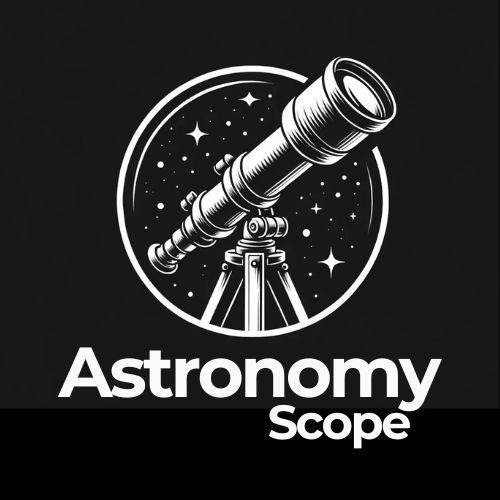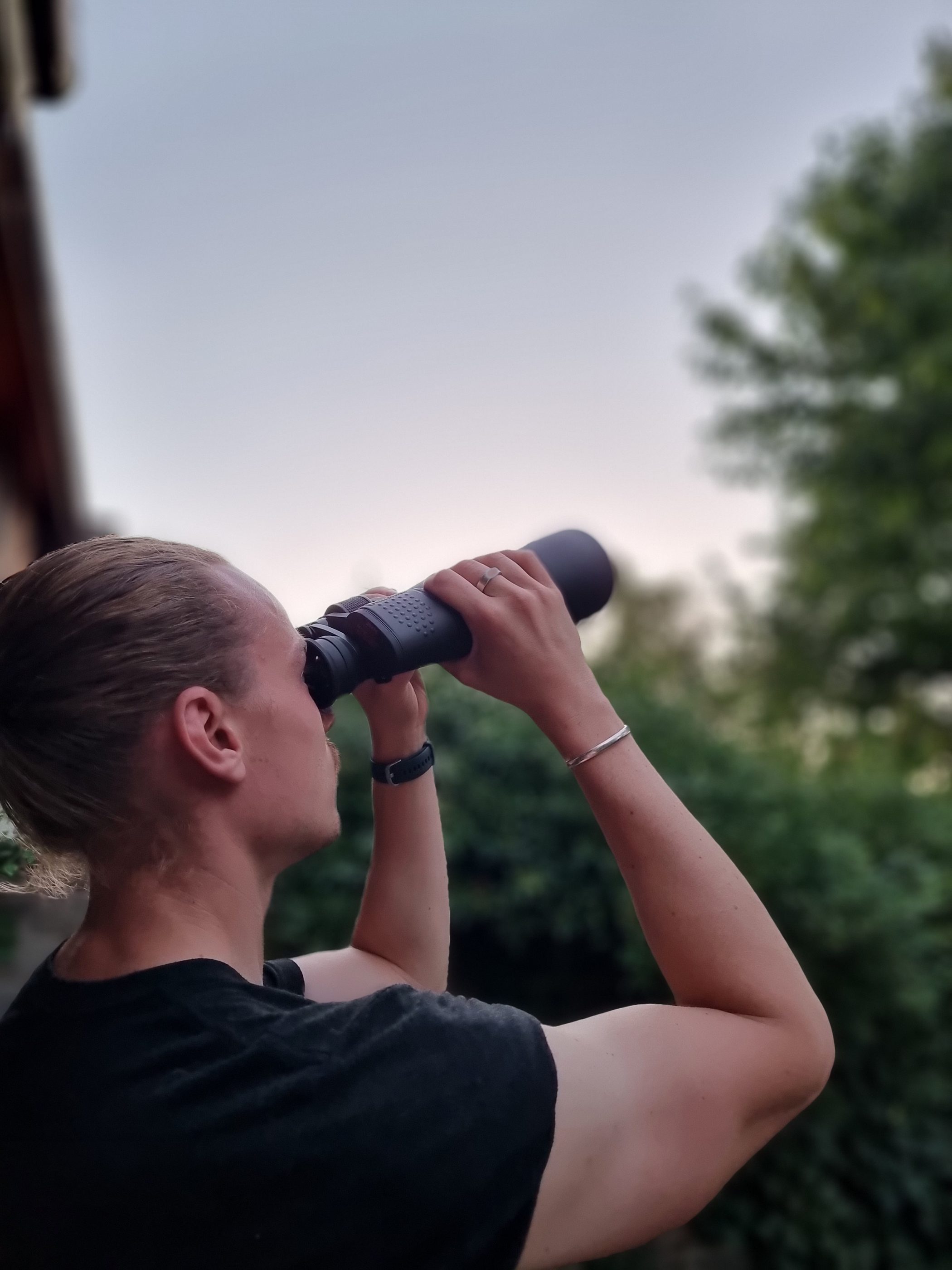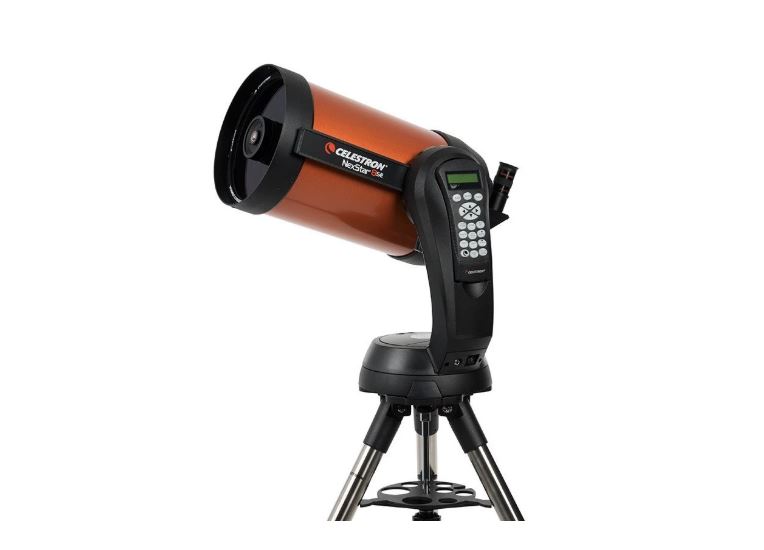Are you looking at the Celestron Nexstar 8SE and wondering if it’s right for you? This review, guide, and outline of my experience will help you decide whether or not to invest in this telescope.
Since I purchased this high-spec computerized telescope, it has become my go-to and favorite astronomy equipment that I expect to use long into the future.
I’d like to share my thoughts having used it for just over 2 years.
The Celestron NexStar 8SE does not come cheap; so you’re going to want to be aware of the features that it offers to justify its price point.
Personally, I love it and what it enables me to do.
I think it’s great for beginners and hopefully this review here today will show you why.
Celestron Nexstar 8SE Review
The Celestron NexStar 8SE telescope is the fourth and last in the Celestron NexStar range. This includes four different sizes Catadioptric telescopes.
Catadioptrics collect and work with the light by utilizing both mirrors and lenses. This provides you with a long focal length but the telescope can remain compact and can have a short body. (Making it more portable, lightweight, etc).
The NexStar range includes four different sizes:
- 4SE (4”),
- 5SE (5”),
- 6SE (6”)
- 8SE (8”).
Every NexStar includes an Altazimuth Mount and a Motorized GoTo tracking system.
This enables you to make the most of 3-star alignment and provides automatic identification and tracking of over 40,000 different celestial objects.
Providing 8″ (Inches) of Aperture, the NexStar 8SE is the ‘power’ variant from the series.
It’s the premium choice with the greatest power and it’s ideal for both new astronomers and those looking to improve their current telescope.
Here is who it is particularly suitable for:
- Those of you with a good budget (between $1200-$1600 – the latter if you are looking to purchase extra accessories)
- Looking for the most powerful telescope within this price range
- Wants to observe the most interesting celestial objects in minimal time (<2 hours)
- Wants to observe over 40,000 fascinating celestial objects with minimal work, setup, and refinement.
The NexStar 8SE is typically more favored than the lower-powered variants (4SE and 5SE).
When you compare its power to the next option down, the 6SE, you can see why. It collects over 77% more light than the 6SE alone!
Celestron NexStar 8SE Specifications & Features
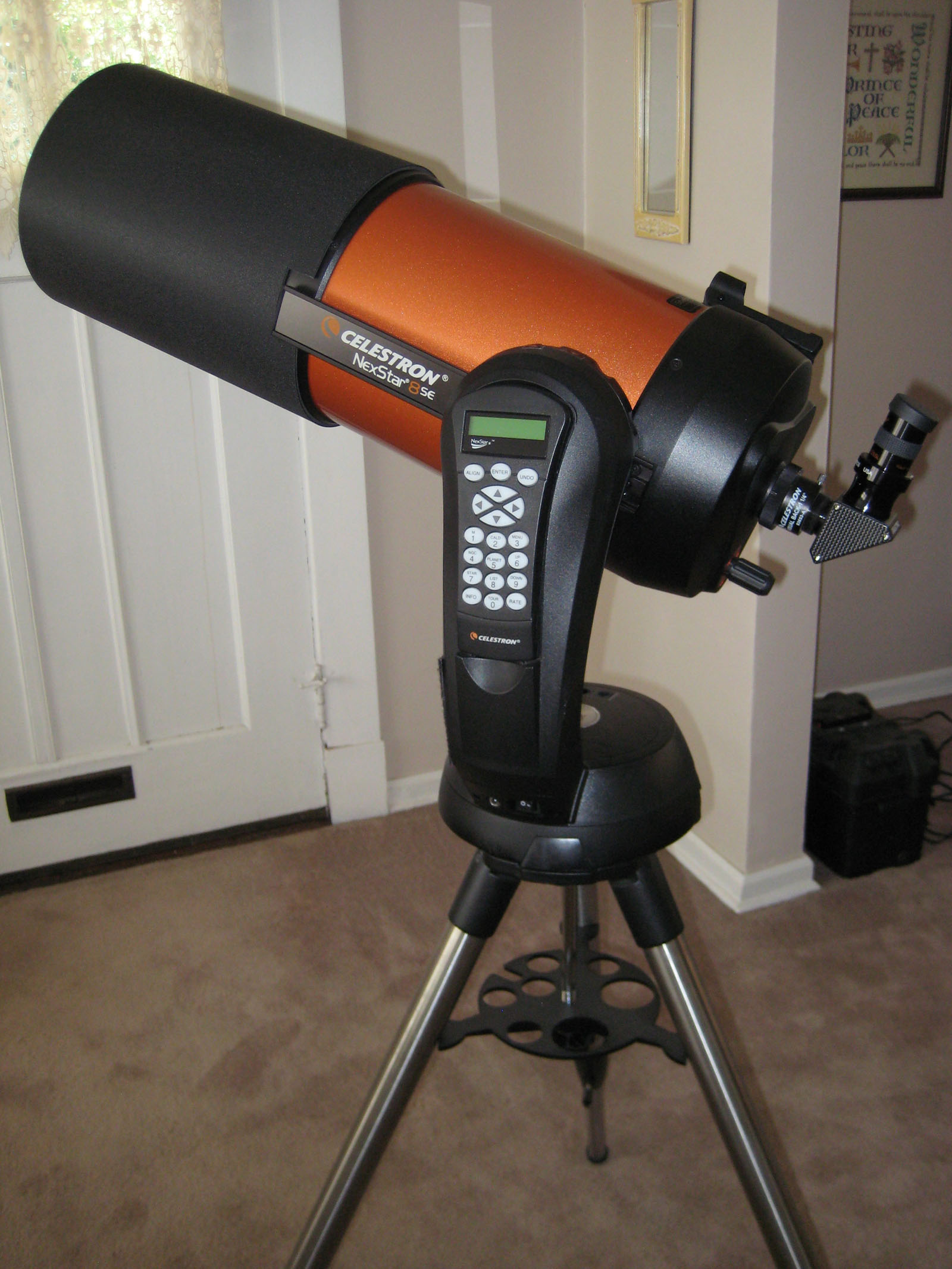
Aperture: 203.2mm (8″)
Focal Length: 2032mm (80″)
Focal Ratio: f10
Maximum Magnification: 480x
Lowest Useful Magnification: 29x
Light Gathering Power: 843x (Compared to the Human Eye)
Motorized: No
Mount Type: Alt-Azimuth & GoTo Motorised Tracking
Total Kit Weight: 24 lbs (10.88 KG)
Price: Check Current Price
The Celestron NexStar 8SE is a Schmidt–Cassegrain Telescope and operates through this Optical Design.
To keep this simple, what this basically means is that the favored components of Reflector and Refractor Telescopes have been combined together.
Essentially, this telescope provides you with increased sharpness and clarity of the night sky from the outset.
One of the standout highlights of the 8SE is of course the 8″ primary mirror combined with its optimal focal length.
With this kind of power, you will be able to observe objects in great detail at the 150-200x magnification level.
You can expect to see the Moon and the Planets within this range, but the 8SE enables you to expand beyond the 200x to observe thousands of other brighter objects.
The large 8″ Aperture enables the dimmer objects (including Galaxies and Nebulae) to be observed in great detail.
If you had a 6″ telescope before or were even considering one, then the additional 2″ will give you 77% more light- which makes a profound difference in what and how you see it.
- Nexstar computerized telescope: The NexStar 8SE Computerized Telescope features Celestron’s iconic orange tube design with updated technology and the latest features for amazing stargazing for beginners and experienced observers.
- 8-Inch aperture: The 8-inch primary mirror in this Schmidt-Cassegrain telescope for adults and kids to be used together packs enough light-gathering ability to observe the best that our Solar System has to offer, while retaining a compact form factor. Compatible with starsense technology, Wifi
- Fully-automated go to mount: Featuring a database of more than 40,000 celestial objects, the go to mount built into our telescopes for astronomy beginners automatically locates and tracks objects for you.
- Easy to assemble and break down: The single fork arm design and sturdy steel tripod all assemble and break down from separate components for easy transportation. SkyAlign technology gets your telescope aligned and ready in minutes.
- Unbeatable warranty and customer support: Buy with confidence from the telescope brand, based in California since 1960. You’ll also receive a 2-year warranty and unlimited access to technical support from our team of US-based experts.
What Can I See With Celestron NexStar 8SE?
Taking into account the viewing conditions, and assuming you have dark skies, you can expect to observe the following celestial objects with the Celestron NexStar 8SE:
- Celestial objects down to magnitude 14. This enables you to observe as far as Pluto with the right viewing conditions.
- Jupiter, its Cloud Bands, Moons (and Shadows)
- Neptune and its moon Triton
- Saturn, its Moons, Surface Bands, Rings, and the Cassini Division
- IceCaps,
- Phobos Moon
- Deimos Moon
- Hundreds of other Galaxies and Nebulae (my favorite is the Messier Catalogue).
- Double Stars
The optics in the NexStar 8SE are robust and durable, ensuring that you can view with great sharpness and detail.
This is enhanced through the inclusion of the StarBright XLT Lens Coatings; which serve the optics in several ways and protect them over time.
The internal computerized database has over 40,000 objects which makes the identification of planets and stars simple.
There’s no manual identification, instead, once you select what you want to see you’ll jump straight to that object so that you can begin observing it.
This gives you so much time and prevents any frustrating periods of being unable to find what you want to see.
The electronics also act to keep objects within your eyepiece over time, as objects will naturally move across the night sky.
Surprisingly, despite its 8″ Aperture and power, this is a relatively compact telescope that minimizes the use of space unlike other Refractor and Newtonian telescopes are known to do.
Whilst sturdy, it’s not overly heavy and it is compact making it far easier to move in the field.
The overall build is quality on the 8SE and it is resilient to damage even if it was to collide with yourself or an object or two.
You can assemble the telescope in a matter of minutes once you unpack it from the box.
In addition, the telescope comes equipped with some fantastic accessories that make it a lot more effective and fun to work with.
This includes: Accessory Tray, Star Pointer Finderscope, NexStar+ Hand Control, 25mm eyepiece, and a Star Diagonal
My Experience
As previously mentioned, I’ve owned the NexStar 8SE for a little over two years now.
It continues to be regularly used and I have no intentions to upgrade any time soon.
I personally spent just under $1700 on my NexStar 8SE setup. The scope cost me just shy of $1200 and then I decided to spend a bit more on some accessories and extras.
My Celestron NexStar 8SE Setup Cost
- Celestron NexStar 8SE Telescope
- GPS
- Baader Zoom
- Telrad Finder Sight
While not all the accessories are required, they have improved my overall experience and enjoyment when using the 8SE.
I purchased the majority of my setup, including the telescope, on Amazon.
This was because of the regular promotions and great offers and the ability to get the items quickly after order.
I have used the telescope on average between 2-3 times per week, making my average cost per use to be just $4-$8!
The Dobsonian was another style of telescope considered, but it’s large and not overly practical for maneuvering and taking with you on the go. I wanted something more compact.
I decided on the 8SE over the other models (4SE,5SE) due to its large Aperture (8”). This has given me a maximum quality view combined with the portability factor.
Regarding accessories, power is one of the most important things with the 8SE. You can either put batteries (8x AA) or you can attach power through the external port, so you do have options.
I personally love to use the Baader Zoom as my lens piece (also available on Amazon).
This enables me to zoom in and out, starting wide to identify an object and zooming in for more detail.
This is a lot more convenient than changing multiple lenses.
The finder that comes with the telescope is sufficient, but the Telrad one (also available on Amazon) is superior in my opinion and experience.
It has a larger field of view and it’s more sturdy and easier to remove at the same time.
The GPS unit I use is a nice extra feature. It allows you to save time by not having to enter your time and location each and every time you use the telescope.
Now before you use your 8SE, I would recommend that you plan your observations ahead of time.
It’s useful to identify what is going to be visible that night and to ensure that your skies are clear up ahead.
It’s also useful to be aware of your constellations and how they align with other objects in the sky.
E.g:
- Big Dipper pointing the Polaris
- Cassiopeia and Pegasus both point to the Andromeda Galaxy and
- Hercules cluster within the Hercules constellation
- Orion Nebula can be identified in the Orion constellation etc.
There is a SkyTour feature in the 8SE which makes it easy to navigate the sky.
For alignment, I use the two-star Auto-Align along with my GPS which makes it simple and easy.
I don’t have to enter the time and location each time I use my scope.
When observing I typically begin with Polaris; given me a clear view of the North Star.
The great thing is, the 8SE will automatically identify another bright star and it will give me a list.
When I am viewing, I usually start with the wider eyepiece (32mm) or the widest setting (24) on my Baadar Eyepiece.
This is a good starting point.
I will then try to go to the object that I am looking to observe, simply typing it into the hand control of the GoTo.
The 8SE has strong motors so you do want to turn off the 8SE when it is not in use, ideally bring it in at night after you have observed.
Using the 8SE, you can study the planets in great detail.
Saturn and Jupiter are great in particular especially the moons which are amazing through this telescope. With Venus, you can see the phases.
The Orion Nebula, Hercules Cluster, the Rose Cluster, the Swan Nebula, and the Andromeda Galaxy are absolutely phenomenal to observe and look superb through the 8SE.
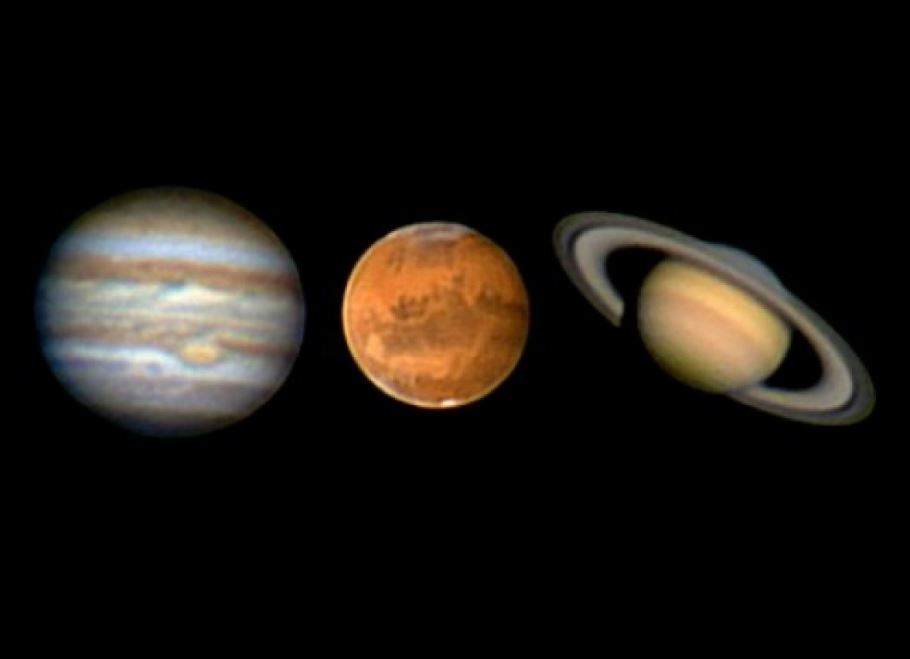
Final Verdict
The 8SE GoTo Telescope is a powerful, intuitive, and premium telescope that is ideal for new astronomers and also those more experienced astronomers who are looking to upgrade their current spec.
Setting up and using a telescope could not be any easier, plus its range of uses and applications never fails to disappoint.
What you are able to see through the 8SE is truly remarkable, and you’ll be surprised at how clear and crisp the images appear from the very outset.
This will be particularly noticeable if you are using a telescope with a 6″ aperture currently.
You’ll instantly benefit from 77% more light and enable you to observe thousands of fainter celestial objects.
The Celestron NexStar 8SE is not cheap, and I would recommend that you get a few optional accessories to improve your experience (Baader Zoom and Telrad Finder).
Sure, this telescope and particular setup are not cheap, but like anything in life, you get what you pay for.
Sure it’s on the more expensive side but this is an investment into a hobby that you’ll enjoy.
Celestron makes their telescopes last and you can expect to use your 8SE for years to come (like I do).
There is one review that I actually read before I purchased the 8SE that sticks in my mind. It was something like: ‘with the 8SE buy it, and don’t think twice!’.
I haven’t.
Related Guides:
- Best Eyepiece For Celestron 8SE
- Celestron Nexstar 4SE vs 8SE
- Celestron Nexstar 6SE vs 8SE
- Celestron Nexstar 4SE vs 5SE
- Celestron Nexstar 6SE Review
- Celestron NexStar 8SE Review
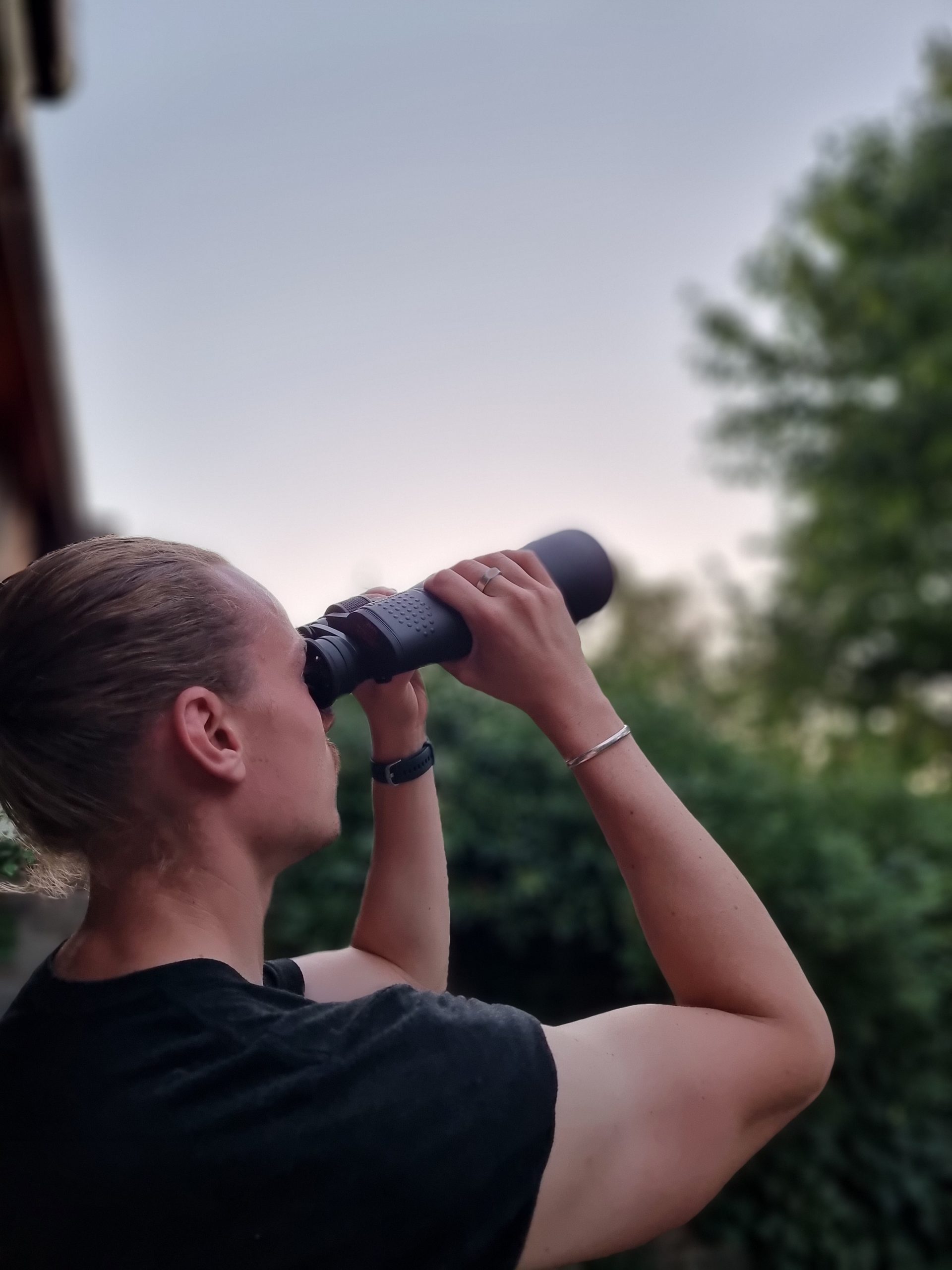
Hey, my name is Jeremy. I’m a passionate and seasoned astronomer who loves nothing more than observing the night sky. I also love researching, learning, and writing all things Space and the Universe. I created Astronomy Scope to share my knowledge, experience, suggestions, and recommendations of what I have learned along the way while helping anyone to get into and maximize their enjoyment of the hobby.
